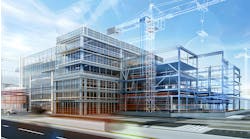There are numerous alternatives available for low-sloped roofing, and building owners, specifiers, and managers face uncertainty in selecting the best system. Contributing to the confusion are changing government regulations, TV images of hurricane-damaged roofs, and the drive for improvements to the bottom line in the face of rising energy and labor costs. Roofing choices often come down to system economics, owner preferences, or the specifier’s experience. Often, a lack of awareness of alternative options can result in a compromised choice for the long term.
A long-term, economical roofing solution often overlooked is acrylic roof coatings. California’s Title 24 law has increased awareness of the energy-saving benefits white roof coatings offer. These coatings, applied to traditional roofing systems, comply with new regulations or help a building obtain ENERGY STAR® or LEED Green Building Rating System® certification.
Building owners and facility managers nationwide are realizing the lasting benefits of elastomeric roof coatings. These durable, liquid coatings prolong the life of the existing roof. In fact, elastomeric roof coatings have been used since the early 1980s over multiple roof types, including BUR, modified bitumen, metal, cement, and EPDM. Many white-coated roofs exist today with excellent adhesion and high solar reflectance - more than 20 years after their initial application.
An elastomeric roof coating creates a uniform, seamless surface that remains flexible even at low temperatures. It expands and contracts with changing weather conditions, protecting a roof’s surface from the sun’s damaging rays. This enables the coating to handle the continuous thermal stresses over the lifetime of the roof. Its adhesion characteristics enable the coating to remain attached to the roof in wet or extremely windy conditions. Such a coating employs technology (to resist dirt pick-up) that helps maintain energy-saving reflectance qualities, as well as a bright, clean appearance.
On existing buildings, elastomeric roof coatings do not add “dead load” or weight to the roof. The roof coating can be applied without being counted as an additional layer for code purposes. This mitigates the cost of disposal from tear-off and contributes to dollars saved by the building owner.
To ensure proper performance from an acrylic roof coating, specification ASTM D-6083 (Standard Specification for Liquid Applied Acrylic Coating Used in Roofing) was developed to define a suitable level of quality. The tests and standards are based on actual in-service performance cases of acrylic roof coatings from numerous manufacturers over various roof types, ranging in age from a few years to 20 years, on roofs located throughout the United States. Anyone using a coating that meets this standard can have confidence that the elastomeric roof coating will perform successfully when properly applied over a sound roof.
In summary, by specifying a high-performing elastomeric roof coating, building owners and facility managers can extend the life of their roofs while improving the energy efficiencies of their buildings. Additional information about elastomeric roof coatings is available at (www.rooftopics.com).
Bernadette Corujo is market manager at Spring House, PA-based Rohm and Haas Co. (www.rohmhaas.com).

